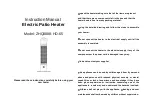
7
Table C. Flow & Pressure Drop
Pressure
Temperature
°F (°C)
SS316L*
B Ti Titanium
Tubeside
190 PSI
150 PSI
406 (208)
Shellside
190 PSI
150 PSI
406 (208)
Model
Boiler
Flow
Boiler
Head Loss
Pool
Flow
Pool
Head Loss
Heating
Surface
SS316L
Titanium
GPM (L/min)
Feet (m)
GPM (L/min)
Feet (m)
Ft² (m²)
Min.
Max.
Min.
Max.
Min.
Max.
Min.
Max.
RP-045
5
(19)
15
(57)
0.5
(0.2)
1.0
(0.3)
20
(76)
40
(152)
1.5
(0.5)
6.0
(1.8)
2.0
(0.19)
RP-075
10
(38)
20
(76)
1.0
(0.3)
2.5
(0.8)
20
(76)
50
(190)
1.5
(0.5)
7.0
(2.1)
2.8
(0.26)
RP-125
10
(38)
20
(76)
1.0
(0.3)
2.5
(0.8)
20
(76)
50
(190)
2
(0.6)
10
(3)
3.3
(0.31)
Ti-180
20
(76)
30
(114)
1.0
(0.3)
2.0
(0.6)
20
(76)
50
(190)
1.5
(0.5)
9.5
(2.9)
4.7
(0.43)
RP-185
20
(76)
30
(114)
1.0
(0.3)
2.0
(0.6)
20
(76)
50
(189)
1.5
(0.45)
9.5
(2.9)
4.9
(0.45)
RP-245
20
(76)
30
(114)
1.0
(0.3)
2.5
(0.8)
30
(114)
60
(227)
2.5
(0.8)
9.0
(2.7)
7.3
(0.68)
Ti-300
20
(76)
35
(133)
1.5
(0.5)
4.0
(1.2)
30
(114)
60
(227)
1.5
(0.5)
6.0
(1.8)
9.0
(0.83)
RP-305
20
(76)
35
(132)
1.5
(0.45)
4.0
(1.2)
30
(114)
60
(227)
1.5
(0.45)
6.0
(1.8)
9.4
(0.87)
RP-495
25
(95)
35
(132)
3.5
(1.0)
6.5
(2.0)
40
(151)
80
(303)
3.0
(0.91)
12.0
(3.6)
17.3
(1.6)
Ti-500
25
(95)
35
(133)
3.5
(1.1)
6.5
(2)
40
(152)
80
(303)
3.0
(0.9)
12
(3.7)
16.8
(1.56)
RP-995
50
(190)
100
(379)
4.0
(1.2)
13
(4)
70
(265)
120
(455)
5.5
(1.7)
15
(4.6)
23.7
(2)
*Designed and fabricated to the ASME B31.3 Process Piping Code.
3. INSTALLATION
GUIDELINES
Plumbing
Connections to the Indirect Pool Heater must be made
with materials that have similar galvanic properties
to the passivated 316 stainless steel or Titanium of
the heat exchanger. Connections to the heat source
plumbing should be made with 300-series stainless
steel nipples. Dielectric unions are recommended if
dissimilar plumbing is used. Connections to the pool
system should be made with CPVC or PVC adapters or
300-series stainless steel nipples. Dielectric unions are
recommended if dissimilar plumbing is used.
The connection diagram, Figure 2, is shown for reference
only. The system must be designed and installed by
a qualified installer and all local, state, provincial and
national codes, laws, regulations and ordinances must
be followed.
Flow
For optimal heat transfer, use counter-flow; the supply
water from the heat source should flow in the opposite
direction of the return water from the pool/spa, as shown
in Figure 2. Systems must be designed to provide flow
rates within the range provided in Table 3. Do not
exceed the published maximum flow rates. On the
heating side, desired flow rates can be accomplished
with pump sizing and/or the use of balancing valves.
Table B. Design Ratings





























